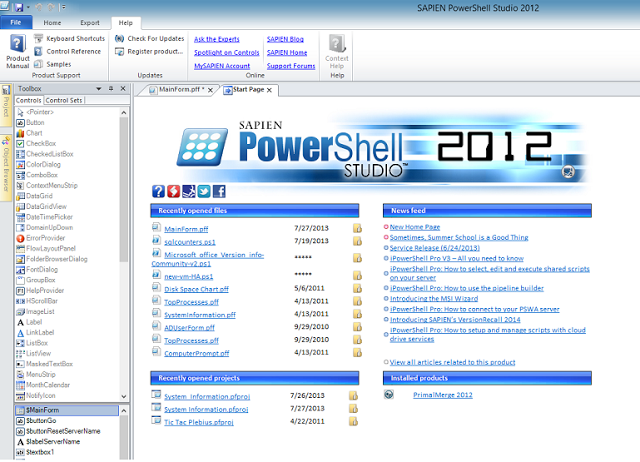

- SAPIEN POWERSHELL STUDIO FORM PROJECT VS MODULE PROJECT SERIES
- SAPIEN POWERSHELL STUDIO FORM PROJECT VS MODULE PROJECT DOWNLOAD
- SAPIEN POWERSHELL STUDIO FORM PROJECT VS MODULE PROJECT WINDOWS
The verb and noun combination we use in the attribute is how the cmdlet will be named in PowerShell. Thankfully, Visual Studio supports the IntelliSense for the verb group and the verbs inside the group.Īfter selecting a verb, we need to add the second parameter to the attribute–the noun we want to use (in our case a noun is Salutation). You will see that in the case of C# we have to define the verb and the noun for the cmdlet. Let’s start by applying the attribute to the default class created in our namespace. The attributes are used even in the same manner so for a person that has written script modules in PowerShell going to C# is very easy. psm1 file and cmdlets are stored in a DLL file. The major difference is that a module with advanced functions is stored in a. Those familiar with PowerShell advanced functions will notice that process for creating a cmdlet in C# is very similar.

We start by adding to the default list that Class template has provided. Once we have the reference assembly in our project we can now use the assembly to get access to the API calls we need to build a PowerShell module. There we select the to add it to our references. Now navigate to C:\Program Files (x86)\Reference Assemblies\Microsoft\WindowsPowerShell\3.0 This folder is created with the installation of Visual Studio 2013. In the Reference Module Manager click on Browse: To do this we right click on Reference in the Solution Explorer and select Add Reference We need to load the library as a reference to our project to make the PowerShell API calls available.

We will be asked to confirm the change and it will re-open the project. Now, on the Application tab we select the target framework from the dropdown list.įor this example project we use a PowerShell 3.0 assembly and we want to support that as the lowest version of PowerShell. NET Framework depending on the lowest version of PowerShell we want to support. Next step is to set the project’s minimum target. For the purpose of this tutorial I will name my project MyModule. We give it a name and specify a location for our project. Select the Visual C# from the installed Templates list and then pick Class Library since compiled modules in PowerShell are in DLL format: Open Visual Studio and create a new project from the File menu:
SAPIEN POWERSHELL STUDIO FORM PROJECT VS MODULE PROJECT WINDOWS
Visual Studio 2013 Express for Windows Desktop version can also be used.
SAPIEN POWERSHELL STUDIO FORM PROJECT VS MODULE PROJECT DOWNLOAD
If you are planning to support Windows PowerShell 2.0 then you will need to download the Windows PowerShell 2.0 SDK from Microsoft. Microsoft has not released a PowerShell 4.0 SDK with reference assemblies using Microsoft. We will use Visual Studio 2013 since it includes the reference assemblies for – the root namespace for Windows PowerShell–for Microsoft.
SAPIEN POWERSHELL STUDIO FORM PROJECT VS MODULE PROJECT SERIES
In the first part of the series we will build a module with just one cmdlet called Get-Salutation that will resemble the traditional “Hello World” example. In this series we will cover the basics of building a Windows PowerShell binary module using C#.


 0 kommentar(er)
0 kommentar(er)
